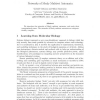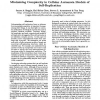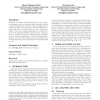14 search results - page 2 / 3 » Molecules as Automata |
IJFCS
2006
13 years 4 months ago
2006
We introduce the networks of Mealy multiset automata, and study their computational power. The networks of Mealy multiset automata are computationally complete. 1 Learning from Mo...
ISMB
1993
13 years 6 months ago
1993
Understanding self-replication from an information processing perspective is important because, amongother things, it can shed light on molecular mechanismsof biological reproduct...
DFT
2005
IEEE
13 years 10 months ago
2005
IEEE
This paper analyzes the deposition defects in devices and circuits made of Quantum-dot Cellular Automata (QCA) for molecular implementation. Differently from metal-based QCA, in ...
LATA
2009
Springer
13 years 11 months ago
2009
Springer
We consider a restricted variant of the hairpin completion called bounded hairpin completion. The hairpin completion is a formal operation inspired from biochemistry. Applied to a ...
GLVLSI
2005
IEEE
13 years 10 months ago
2005
IEEE
Quantum-dot Cellular Automata (QCA) is a novel computing mechanism that can represent binary information based on spatial distribution of electron charge configuration in chemica...



